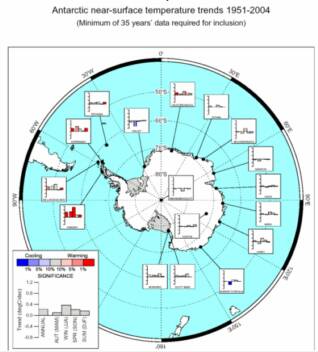Click here to add text.
Current Climate Status

More Coming soon
http://data.giss.nasa.gov

http://environment.newscientist.com/channel/earth/dn11462
New Scientist - Climate change: A guide for the perplexed
I Was On the Global Warming Gravy Train : David Evans
http://www.mises.org/story/2571
The Northern hemisphere is currently cooling as of 2007 and as the planet attempts to equalize it's hydrodynamics, it has not been able to do it fast enough which has caused the mean global temperature to rise over the past 100 years. The largest impact comes from our thinning atmosphere, ozone depletion and hydrology shift, as solar radiation is no longer blocked by ozone it is blocked by clouds that are formed by cosmic rays. There is an 11 year fluctuation involving the solar variable which last took about two to four years to equalize to end at a higher temperature between 1998 & 2006. This does not negate the effects of global broadcast on ozone depletion which is best observed on the five year mean. It is also important to note that the latest down turn in global temperature comes at the same time when the the UK begins the switch to digital on October 17th 2007 which produced a predicted ozone anomaly. The current total transmitter power in the UK is much lower until the switchover is complete in 2012 at which time digital broadcasting will resume full power (and deplete more ozone).
European broadcast is particularly powerful in it's effects on the climate change process because analogue television broadcasts using LW (long wave) FM for sound. LW FM was found to cause considerable ionospheric disturbance (REP) in 1944 according to Kenneth Norton an FCC engineer who cross referenced data between the war department and WGTR in Paxton, Massachusettes. CO2 climate change is an attempt to mitigate Peak Oil concerns.
Note to those of you who are yet convinced that the climate is changing at all, please visit NASA's website for the latest in climate statistics.
For those of you who feel the urban heat island effect has skewed these statistics note that only measuring stations that are close to a rural counterpart were considered in NASA's measurements.
For those of you who feel that the global temperature has leveled out : If you really believe this is somehow natural, then understand that it is simply not possible for the temperature to level out in the flux of natural cycles. It would be quite unnatural for this to occur. (see Broadcast Theory)
The largest problem with climate change is the slow speed at which new information disseminates to the public and the ability of scientists to consider and collaborate on new ideas outside of their niche, because most scientists only consider ideas from what they study and know.
While the most concerning effects that global warming has on humanity is fear and possibility of a pandemic, the greatest threat is to the ecosystem and microclimates that cannot survive or adapt because their habitat is out of their temperature range. This will drive many species to extinction. Thus the effects of climate change are relative to your perspective.
Are you only thinking about yourself or the whole picture?
Educate yourself and elevate the human condition !
Back

1.Both experimental and model studies of long-term climate changes above Antarctica continent indicate presence of strong climate warming at the region around the Antarctic peninsula which differs significantly from the climate tendency in other parts of Antarctica. This warming is the most intense on the Earth together with similar regions of warming located in Alaska and in North-East Siberia. Another climatic anomaly in this region is a giant spot of the open water (polynya) which does not freeze in wintertime. Up to now all attempts to explain these phenomena by the traditional meteorological factors turned out to be inadequate.
2. It is shown in this paper that the region of intense global warming around Antarctic peninsula precisely coincides with a stable maximum of energetic electron precipitation (E > 1 MeV) from the Earth radiation belt. Depth of penetration of these particles into atmosphere could be as low as 20-40 km.
3. Energetic resources of this phenomenon are quite sufficient in order to supply input of thermal energy capable to warm atmosphere in this region.
4. Further study of interaction between the auroral and mid-latitude atmospheres during geomagnetic storms and superstorms is an important part of the solar-terrestrial physics. There are a lot of things to be done in this direction.
Source: http://www.cosis.net/abstracts/EMS2006/00027/EMS2006-A-00027.pdf?PHPSESSID=3
Antarctic Cooling or Warming ? : Peculiarities of Long-Term Trends of Surface Temperature in Antarctica and Their Possible Connections with Outer Belt Electron Precipitation
What about CFC's ?
The antarctic "ozone hole" has reached record sizes in recent years, DESPITE the abolition of CFCs. The latest reading is not as big as the record 28 million sq km holes that developed during 2000, 2003 and 2006 but is close to it. As the world marks 20 years since the introduction of the Montreal Protocol to protect the ozone layer, experimental data that threatens to shatter established theories of ozone chemistry. If the data are right, scientists will have to rethink their understanding of how ozone holes are formed and how that relates to climate change. NASA's Jet Propulsion Laboratory in Pasadena, California has discovered new data for the break-down rate of a crucial molecule, dichlorine peroxide (Cl2O2). The rate of photolysis (light-activated splitting) of this molecule was extremely low in the wavelengths available in the stratosphere - almost an order of magnitude lower than the currently accepted rate.
What does this mean to them?
"The result was a shock: at least 60% of ozone destruction at the poles seems to be due to an unknown mechanism."
http://groups.google.com.fj/group/sci.skeptic/browse_thread/thread/772148efe6c2e938
Why is the ozone hole still growing?
The Antarctic ozone hole is an area of the Antarctic stratosphere in which the recent ozone levels have dropped to as low as 33% of their pre-1975 values. The ozone hole occurs during the Antarctic spring, from September to early December, as strong westerly winds start to circulate around the continent and create an atmospheric container. Within this "polar vortex", over 50% of the lower stratospheric ozone is destroyed during the Antarctic spring.
"From September 21 to 30, the average area of the ozone hole was the largest ever observed, at 10.6 million square miles," said Paul Newman, atmospheric scientist at NASA's Goddard Space Flight Center, Greenbelt, Md. If the stratospheric weather conditions had been normal, the ozone hole would be expected to reach a size of about 8.9 to 9.3 million square miles, about the surface area of North America
"These numbers mean the ozone is virtually gone in this layer of the atmosphere," said David Hofmann, director of the Global Monitoring Division at the NOAA Earth System Research Laboratory. "The depleted layer has an unusual vertical extent this year, so it appears that the 2006 ozone hole will go down as a record-setter."
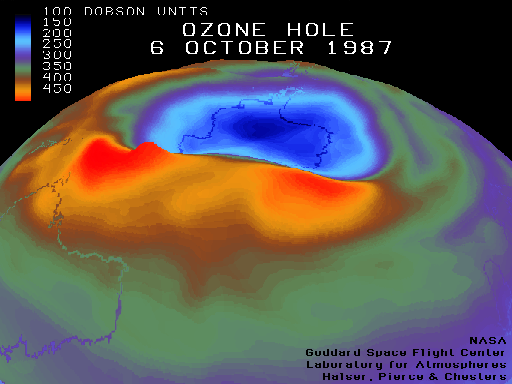
How does this effect polar ice caps?
Parts of the polar regions, Antarctica and the Arctic, are already warming two to three times faster than the global average, which is predicted to be between 1.4 and 5.8 degrees Celsius this century. More heat is absorbed by the sea than by ice and this promotes faster melting because less sunlight is being reflected back into space.
* Climate models predict global warming will be most acute in polar regions. Some predict an almost complete loss of summer sea-ice in the Arctic before the end of the century -- meaning polar bears, which depend on the sea ice to hunt seals and move around, are unlikely to survive.
* The Greenland Ice Sheet, the Arctic's largest glacial mass, constitutes 10 percent of the world's freshwater reserves. It is currently melting faster than new ice is being formed. If all Greenland ice melted, the world's oceans would rise by seven metres (23 feet).
* Polar regions act as natural "sinks" for the world's toxic chemicals. Persistent organic pollutants (POPs) are carried to the Arctic by air and ocean currents and enter the food chain of marine mammals and seabirds.
* The Arctic is a partially frozen ocean. Its snow-covered tundra and forests has few native species but is home to four million people, of whom 10 percent are indigenous. In the southern hemisphere, Antarctica is a continent surrounded by ocean. About 99 percent of Antarctica is covered by ice and is home to large populations of marine birds and seals.
http://www.javno.com/en/lifestyle/clanak.php?id=50080
http://www.nasa.gov/vision/earth/lookingatearth/ozone_record.html

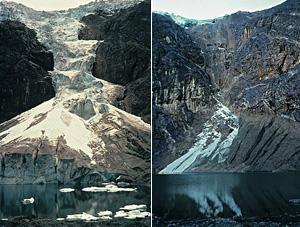
CFC's have been on the decline since 2000, yet the largest ozone hole was October 2006 and scientists are beginning to wonder why the hole isn't closing. The IPCC can't measure the effects of solar particles that deplete ozone accurately and they don't consider radio pollution at all!
Click to Enlarge
Frequently Asked Questions
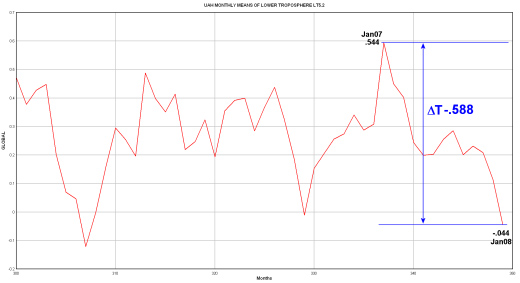

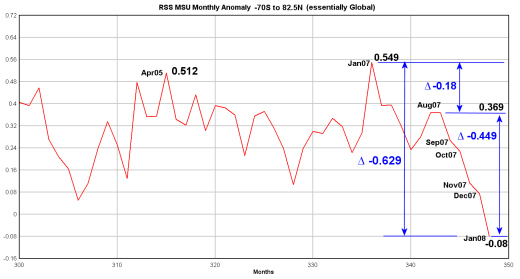
This is some of the latest information on the temperature downturn of 2007
http://wattsupwiththat.wordpress.com/2008/02/19/january-2008-4-sources-say-globally-cooler-in-the-past-12-months/
WWII Beurau of Standards Report : FCC Kenneth Norton
http://ieee.cincinnati.fuse.net/reiman/09_1994.html
Recent News : Last Updated December 10 2008
2008 Sees Fifth Largest Ozone Hole:
ScienceDaily (Nov. 6, 2008) — The ozone hole over Antarctica, which fluctuates in response to temperature and sunlight, grew to the size of North America in a one-day maximum in September that was the fifth largest on record, since NOAA satellite records began in 1979.
The Antarctic ozone hole reached its annual maximum on Sept. 12, 2008, stretching over 27 million kilometers, or 10.5 square miles. The area of the ozone hole is calculated as an average of the daily areas for Sept. 21-30 from observations from the Ozone Monitoring Instrument (OMI) on NASA’s Aura satellite.
NOAA scientists, who have monitored the ozone layer since 1962, have determined that this year’s ozone hole has passed its seasonal peak for 2008. Data is available at online.
The primary cause of the ozone hole is human-produced compounds called chlorofluorocarbons, or CFCs, which release ozone-destroying chlorine and bromine into the atmosphere. Earth’s protective ozone layer acts like a giant umbrella, blocking the sun’s ultraviolet-B rays. Though banned for the past 21 years to reduce their harmful build up, CFCs still take many decades to dissipate from the atmosphere.
According to NOAA scientists, colder than average temperatures in the stratosphere may have helped play a part in allowing the ozone hole to develop more fully this year.
“Weather is the most important factor in the fluctuation of the size of the ozone hole from year-to-year,” said Bryan Johnson, a scientist at NOAA’s Earth System Research Laboratory in Boulder, which monitors ozone, ozone-depleting chemicals, and greenhouse gases around the globe. “How cold the stratosphere is and what the winds do determine how powerfully the chemicals can perform their dirty work.”
NASA satellites measured the maximum area of this year’s ozone hole at 10.5 million square miles and four miles deep, on Sept. 12. Balloon-borne sensors released from NOAA’s South Pole site showed the total column of atmospheric ozone dropped to its lowest count of 107 Dobson units on Sept. 28. Dobson units are a measure of total ozone in a vertical column of air.
In 2006, record-breaking ozone loss occurred as ozone thickness plunged to 93 Dobson units on Oct. 9 and sprawled over 11.4 million square miles at its peak. Scientists blamed colder-than-usual temperatures in the stratosphere for its unusually large size. Last year’s ozone hole was average in size and depth.
Starting in May, as Antarctica moves into a period of 24-hour-a-day darkness, rotating winds the size of the continent create a vortex of cold, stable air centered near the South Pole that isolates CFCs over the continent. When spring sunshine returns in August, the sun’s ultraviolet light sets off a series of chemical reactions inside the vortex that consume the ozone. The colder and more isolated the air inside the vortex, the more destructive the chemistry. By late December the southern summer is in full swing, the vortex has crumbled, and the ozone has returned—until the process begins anew the following winter.
The 1987 Montreal Protocol and other regulations banning CFCs reversed the buildup of chlorine and bromine, first noticed in the 1980s.
“These chemicals—and signs of their reduction—take several years to rise from the lower atmosphere into the stratosphere and then migrate to the poles,” said NOAA’s Craig Long, a research meteorologist at NOAA’s National Centers for Environmental Prediction. “The chemicals also typically last 40 to 100 years in the atmosphere. For these reasons, stratospheric CFC levels have dropped only a few percent below their peak in the early 2000s.“
“The decline of these harmful substances to their pre-ozone hole levels in the Antarctic stratosphere will take decades,” said NOAA atmospheric chemist Stephen Montzka of the Earth System Research Laboratory. “We don’t expect a full recovery of Antarctic ozone until the second half of the century.”
Digital Switch in the US is June 12th!


